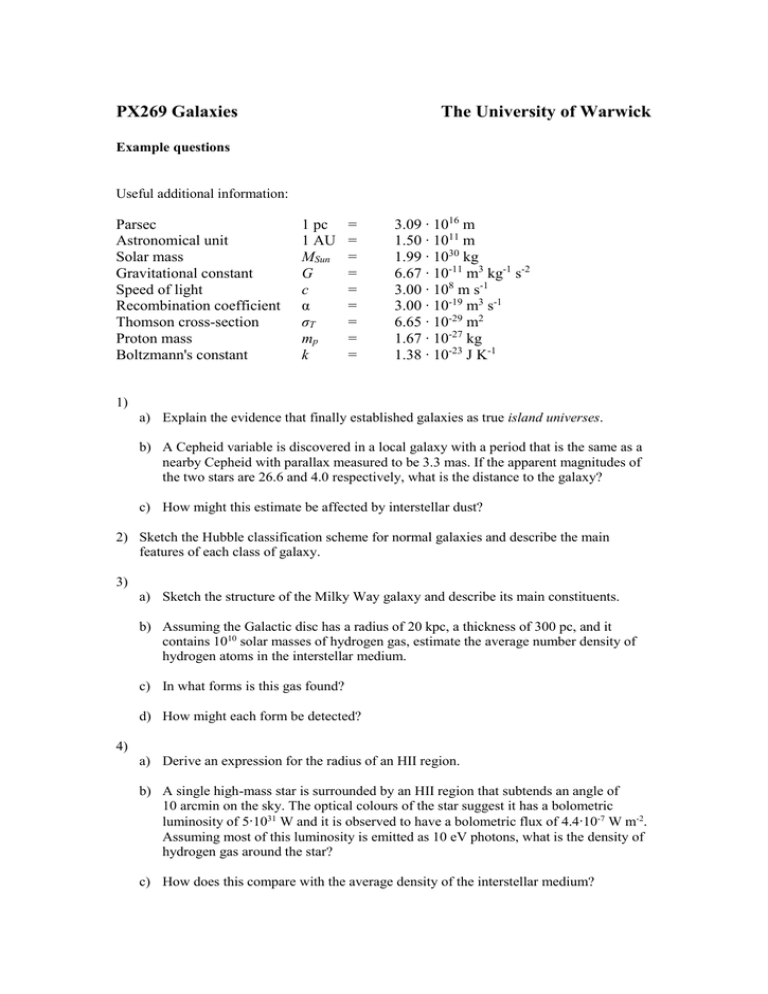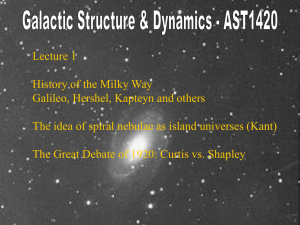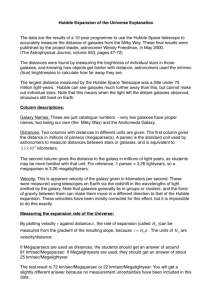PX269 Galaxies ...
advertisement

PX269 Galaxies The University of Warwick Example questions Useful additional information: Parsec Astronomical unit Solar mass Gravitational constant Speed of light Recombination coefficient Thomson cross-section Proton mass Boltzmann's constant 1 pc 1 AU MSun G c α σT mp k = = = = = = = = = 3.09 ∙ 1016 m 1.50 ∙ 1011 m 1.99 ∙ 1030 kg 6.67 ∙ 10-11 m3 kg-1 s-2 3.00 ∙ 108 m s-1 3.00 ∙ 10-19 m3 s-1 6.65 ∙ 10-29 m2 1.67 ∙ 10-27 kg 1.38 ∙ 10-23 J K-1 1) a) Explain the evidence that finally established galaxies as true island universes. b) A Cepheid variable is discovered in a local galaxy with a period that is the same as a nearby Cepheid with parallax measured to be 3.3 mas. If the apparent magnitudes of the two stars are 26.6 and 4.0 respectively, what is the distance to the galaxy? c) How might this estimate be affected by interstellar dust? 2) Sketch the Hubble classification scheme for normal galaxies and describe the main features of each class of galaxy. 3) a) Sketch the structure of the Milky Way galaxy and describe its main constituents. b) Assuming the Galactic disc has a radius of 20 kpc, a thickness of 300 pc, and it contains 1010 solar masses of hydrogen gas, estimate the average number density of hydrogen atoms in the interstellar medium. c) In what forms is this gas found? d) How might each form be detected? 4) a) Derive an expression for the radius of an HII region. b) A single high-mass star is surrounded by an HII region that subtends an angle of 10 arcmin on the sky. The optical colours of the star suggest it has a bolometric luminosity of 5∙1031 W and it is observed to have a bolometric flux of 4.4∙10-7 W m-2. Assuming most of this luminosity is emitted as 10 eV photons, what is the density of hydrogen gas around the star? c) How does this compare with the average density of the interstellar medium? 5) a) Show that knowledge of the orbit of the Earth can be used to measure the mass of the Sun. b) Explain how a related method can be used to estimate the mass of a spiral galaxy. c) What assumptions and limitations are implicit in this method? d) The Sun orbits the centre of the Milky Way at a distance of ~8 kpc and with an orbital velocity of ~220 km s-1. What limits does this place on the total mass of the Milky Way? e) How might the orbital velocity of the Sun be determined? 6) a) Derive an expression for the radial velocity of HI clouds in the disc of the Milky Way. b) Explain how the measurement of these radial velocities can be used to determine the rotation curve of the Galaxy within the Solar circle. c) What additional information is required to measure the rotation curve outside the Solar circle? d) At what wavelength are these observations made and why? e) How do such observations provide evidence for dark matter? 7) a) Explain what is meant by the extragalactic distance ladder and outline its key components. b) Several years after the explosion of SN1987A an elliptical ring appeared around the remnant with a semi-major axis of 0.83 arcsec and a semi-minor axis of 0.62 arcsec. The ring brightened asymmetrically over a period of 340 days. Use this information to determine the distance to the Large Magellanic Cloud (LMC). c) What is the advantage of this method over other methods for determining the distance to the LMC? d) Two spiral galaxies are observed to be equally bright. One has a rotational velocity of 100 km s-1 the other has a velocity of 200 km s-1. Use the Tully-Fisher relation to estimate their relative distances. 8) a) Use the virial theorem to derive an expression relating the mass of an elliptical galaxy to the radial velocity dispersion of its stars. b) Three elliptical galaxies are observed: galaxy-1 has a half-light radius of re=0.3 kpc and a radial velocity dispersion at this radius of σr=17 km s-1; galaxy-2 has re=3 kpc and σr=9.4 km s-1; galaxy-3 has re =150 kpc and σr=240 km s-1. i) Estimate the mass of each galaxy. ii) To which of the main classes of elliptical galaxies does each galaxy belong (i.e. cD, dE or E)? iii) Which of the galaxies are likely to contain hot gas and why? 9) a) Outline the main observational properties of: i) Seyfert galaxies ii) Radio galaxies iii) Quasars b) Show that the properties of these objects can be understood only in terms of accretion by a supermassive black hole. c) Describe the evidence indicating the presence of a black hole of mass 4∙106MSun at the centre of the Milky Way. d) If this Milky Way black hole began to accrete again: i) What would be its highest possible luminosity? ii) How quickly could it vary in brightness?







